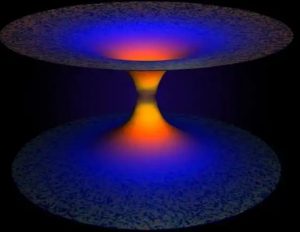
Theoretical physicists developed a theory called loop quantum gravity in the 1990s that marries the laws of microscopic physics, or quantum mechanics, with gravity, which explains the dynamics of space and time. Ashtekar, Olmedos and Singh’s new equations describe black holes in loop quantum gravity and showed that black hole singularity does not exist.
“In Einstein’s theory, space-time is a fabric that can be divided as small as we want. This is essentially the cause of the singularity where the gravitational field becomes infinite. In loop quantum gravity, the fabric of space-time has a tile-like structure, which cannot be divided beyond the smallest tile. My colleagues and I have shown that this is the case inside black holes and therefore there is no singularity,” Singh said.
Instead of singularity, loop quantum gravity predicts a funnel to another branch of the space-time.
“These tile-like units of geometry–called ‘quantum excitations’– which resolve the singularity problem are orders of magnitude smaller than we can detect with today’s technology, but we have precise mathematical equations that predict their behavior,” said Ashtekar, who is one of the founding fathers of loop quantum gravity.
“At LSU, we have been developing state-of-the-art computational techniques to extract physical consequences of these physical equations using supercomputers, bringing us closer to reliably test quantum gravity,” Singh said.
Einstein’s theory fails not only at the center of the black holes but also to explain how the universe was created from the Big Bang singularity. Therefore, a decade ago, Ashtekar, Singh and collaborators began to extend physics beyond the Big Bang and make new predictions using loop quantum gravity. Using the mathematical equations and computational techniques of loop quantum gravity, they showed that the Big Bang is replaced by the “Big Bounce.” But, the problem of overcoming black hole singularity is exceptionally complex.
“The fate of black holes in a quantum theory of gravity is, in my view, the most important problem in theoretical physics,” said Jorge Pullin, the Horace Hearne professor of theoretical physics at LSU, who was not part of this study.

